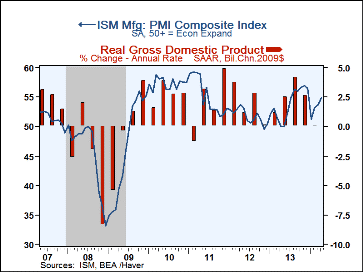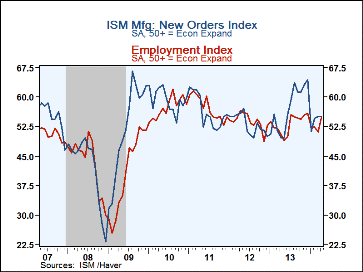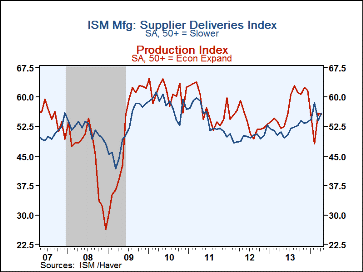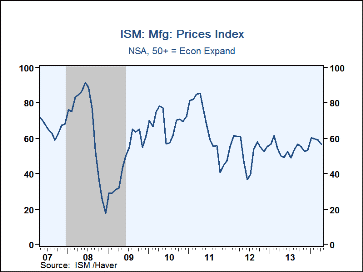 Global| May 01 2014
Global| May 01 2014U.S. ISM Index Increase is Driven by Higher Employment
by:Tom Moeller
|in:Economy in Brief
Summary
Factory sector activity is improving with the end of a rough winter and more hiring. The Composite Index of Manufacturing Sector Activity from the Institute for Supply Management improved to 54.9 during April from an unrevised 53.7 in [...]
Factory sector activity is improving with the end of a rough winter and more hiring. The Composite Index of Manufacturing Sector Activity from the Institute for Supply Management improved to 54.9 during April from an unrevised 53.7 in March. It was the highest reading since December but remained below the November peak of 57.0. The latest reading beat expectations for 54.2 as measured by the Action Economics Forecast Survey. Any figure above 50 indicates an increasing level of factory sector activity. During the last ten years, there has been a 76% correlation between the ISM index and the q/q change in real GDP.
A sharp gain in the employment reading to 54.7 from 51.1 was the largest component increase. The latest was the highest reading since December. During the last ten years there has been an 88% correlation between the employment index and the m/m change in factory payrolls. That increase was followed by the supplier deliveries series which improved to 55.9 and recovered a piece of the March decline. The latest level continues the upward trend, showing slower delivery speeds, in place since early 2012. The inventories index also improved moderately. The new orders series was, however, unchanged and the production figure moved slightly lower. The new export orders index rose to 57.0, the highest level since November, but the imports index surged to 58.0, equaling the August high.
The prices paid index series declined to 56.5, the lowest level since December. Twenty five percent of firms raised prices while twelve percent lowered them. During the last ten years there has been a 67% correlation between the index and the m/m change in the intermediate producer price index.
The figures from the Institute For Supply Management (ISM) are diffusion indexes and can be found in Haver's USECON database. The expectations number is in the AS1REPNA database.
| ISM Mfg | Apr | Mar | Feb | Apr'13 | 2013 | 2012 | 2011 |
|---|---|---|---|---|---|---|---|
| Composite Index | 54.9 | 53.7 | 53.2 | 50.0 | 53.9 | 51.8 | 55.2 |
| New Orders | 55.1 | 55.1 | 54.5 | 49.7 | 57.2 | 53.1 | 56.4 |
| Production | 55.7 | 55.9 | 48.2 | 52.1 | 57.7 | 53.8 | 57.4 |
| Employment | 54.7 | 51.1 | 52.3 | 50.5 | 53.2 | 53.8 | 57.4 |
| Supplier Deliveries | 55.9 | 54.0 | 58.5 | 51.1 | 51.9 | 50.0 | 54.7 |
| Inventories | 53.0 | 52.5 | 52.5 | 46.5 | 49.4 | 48.2 | 50.1 |
| Prices Paid Index (NSA) | 56.5 | 59.0 | 60.0 | 50.0 | 53.8 | 53.2 | 65.2 |
Tom Moeller
AuthorMore in Author Profile »Prior to joining Haver Analytics in 2000, Mr. Moeller worked as the Economist at Chancellor Capital Management from 1985 to 1999. There, he developed comprehensive economic forecasts and interpreted economic data for equity and fixed income portfolio managers. Also at Chancellor, Mr. Moeller worked as an equity analyst and was responsible for researching and rating companies in the economically sensitive automobile and housing industries for investment in Chancellor’s equity portfolio. Prior to joining Chancellor, Mr. Moeller was an Economist at Citibank from 1979 to 1984. He also analyzed pricing behavior in the metals industry for the Council on Wage and Price Stability in Washington, D.C. In 1999, Mr. Moeller received the award for most accurate forecast from the Forecasters' Club of New York. From 1990 to 1992 he was President of the New York Association for Business Economists. Mr. Moeller earned an M.B.A. in Finance from Fordham University, where he graduated in 1987. He holds a Bachelor of Arts in Economics from George Washington University.










